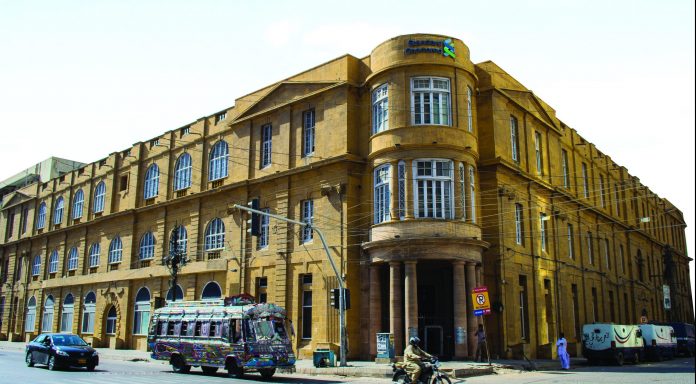Stand outside the branch of Standard Chartered Bank Pakistan on Karachi’s historic McLeod Road, and it is difficult to escape a sense of history. The weathered façade of the building – with its colonial architecture – practically screams out the fact that this bank has been doing business in this city since before the invention of the typewriter.
But walk inside (or download their app on your smartphone) and you will find the most sophisticated banking technology available in the country, allowing a customer to complete virtually all routine transactions without the need for human interaction.
By rights, that combination of a storied history and modern technological capabilities should make Standard Chartered one of the most important financial institutions in the country, and certainly one poised for robust growth in the coming decades. Standard Chartered’s leadership certainly likes promoting that image, with both CEO Bill Winters and Chairman José Viñals visiting Pakistan in 2017.
“Standard Chartered is optimistic and excited to actively participate in [Pakistan’s economic] turnaround,” said Bill Winters, in public remarks during his visit to Pakistan in March 2017.
“We are rooted in the real economy; so what is good for Pakistan is good for us,” said José Viñals, during his trip to the country in May 2017, shortly after being appointed the chairman of the bank’s board of directors. “Standard Chartered will do all things that are important for the economic and financial development of Pakistan,” he said.

But, barring a swift and dramatic shift in strategy, the bank’s Pakistani subsidiary is more likely to suffer the same fate as Citibank Pakistan: another once-dominant institution that faltered in its growth strategy in the last 2000s and then shriveled away until it was forced to sell off its retail presence entirely to Habib Bank in 2012, retaining only a rump of a corporate banking presence in the country.
Were that to happen, it would be the end of a remarkable history: a bank that predates the country’s existence by decades and has long served as one of the region’s most important financial links to global capital markets. This is the story of how Standard Chartered came to occupy that role, and where it might be headed next.
An old emerging markets powerhouse
Like many of the world’s most interesting stories about financial institutions, Standard Chartered is the brainchild of a Scottish entrepreneur.
James Wilson was the son of a wealthy textile mill owner in Scotland but had no interest in working with his father’s business. In 1824, at age 19, he moved to London to start his own business, engaging mostly in international trade. In response to British protectionist trade policies of the era, in 1843, Wilson launched The Economist, a newspaper dedicated to promoting free trade and economic liberalism.
In 1853, he sought – and received – a royal charter to create his own bank, which he named the Chartered Bank of India, Australia and China. The bank began operations in 1858, opening branches in Shanghai, Bombay, and Calcutta that year. The next year, it opened branches in Hong Kong and Singapore. And in 1863, it opened a branch in Karachi, making Standard Chartered (its successor entity) the oldest financial institution in the country.

The bank got its current name after the 1969 merger with the Standard Bank of British South Africa, a bank founded by another Scotsman, John Paterson. While both banks were founded in London, both did not have any retail presence in the United Kingdom, focusing their businesses almost exclusively on financing trade in the British Empire and its broader sphere of economic influence. Even today, the bank derives more than 90% of its profits from Asia, Africa, and the Middle East.
In more than a century and a half of its presence in what is now Pakistan, the bank has grown both organically and through acquisitions. In 2000, it acquired the India and Pakistan operations of ANZ Grindlays Bank, which was then the second oldest financial institution in Pakistan, having established its first branch in Karachi in 1883. (Grindlays opened a branch in Lahore in 1924 and Peshawar in 1926).
The big acquisition – and one that truly transformed Standard Chartered from being a foreign bank to the country’s only “local foreign” bank – came in August 2006, when it bought Union Bank for a transaction ultimately worth $511 million, still the largest acquisition of a bank in Pakistani history.
Union Bank had been founded in 1991 and its largest shareholder was the Saudi national Abdullah Mohammad Abdullah Basodan, a director and shareholder of Al Murjan Holdings. Al Murjan is the family business of the Khalid Bin Mahfouz, the Saudi financier who was one of the founders of Bank of Credit and Commerce International (BCCI).
At the time of the acquisition, Standard Chartered had 43 branches in Pakistan and Union Bank had 65 branches. The combined entity became the sixth largest bank in the country and gave Standard Chartered the ability to say that it was truly a global bank with a nationwide local branch network.

The (brief) expansion drive
The logic behind the acquisition was sound: buy a local bank and bring it up to global standards, becoming the only global brand with a local branch network in the process. HSBC may brag about being “the world’s local bank” in its advertising slogans, but Standard Chartered actually put its money where its mouth is, at least as far as the Pakistani market is concerned.
The Union Bank acquisition was not StanChart buying the local operations of another foreign bank. Union Bank was as local as local banks get in Pakistan. Its CEO at the time of the acquisition was Shaukat Tarin (who then owned 5% of the bank), the legendary head of Citibank Pakistan in its heyday in the early 1990s when Citibank practically invented consumer banking as it is known today in the country. Tarin later served as federal finance minister.
It would have been tempting to simply buy Union Bank’s branch network and declare victory. But that is not what Standard Chartered’s management did. Badar Kazmi, its CEO at the time, decided to use the platform offered by the acquisition to further expand the bank’s presence in Pakistan. Standard Chartered went from 108 branches at the time of the transaction in August 2006 to 174 branches by June 2008. In retrospect, the timing may not have been ideal.
The expansion, needless to say, did not come cheap. Even after consolidating the impact of the merger, Standard Chartered’s operating costs jumped by almost 137% to Rs12.2 billion in 2007, causing the combined entity to suffer a 50% drop in profit margins that year. Then came the financial crisis of 2008, and with it an attendant sharp rise in non-performing loans, causing net income to plummet by nearly 75% in 2008. Profits were now down to just Rs723 million ($10.3 million), a far cry from just two years earlier when, in 2006, profits had hit a then-record amount of Rs5,698 million ($94.6 million).

That sharp decline in profits was enough to scare off Standard Chartered’s management, and the bank began almost immediately scaling back its expansion. The bank closed 12 branches in 2009, 19 in 2011, 13 in 2012. It has kept closing branches almost every year since 2008 (except 2010 and 2014) and, as of June 30, 2017, is now down to just 97 branches. That is fewer branches than it had after it bought Union Bank.
In search of a strategy, in both Pakistan and globally
Even though 2008 was a bad year for Standard Chartered Pakistan, it was actually one of the best years for the bank globally. Think about where the world stood in late 2007 and 2008: the global bond market had begun melting down in August 2007, and global stock markets followed suit shortly thereafter. The year 2008 was a horrendously bad one for virtually every major financial institution in the world. Except one.
Even as its peer institutions bled money and were bailed out by their governments, in some cases nationalized by the British government, Standard Chartered did the unthinkable: it posted record revenue and profit numbers. In the year ending December 31, 2008, Standard Chartered revenues grew by 26.2% to $14 billion and profits by 20% to $3.4 billion. (Even though it is a UK-listed entity, Standard Chartered publishes its financial statements in US dollars.) Those numbers would be astounding even in the middle of an economic boom. That this growth took place in the middle of the worst global financial crisis in nearly a century makes it positively miraculous.

At that moment, the bank became the darling of virtually every investor who dared invest in bank stocks. For the next four years, StanChart continued to grow both revenues and profits. Analysts cheered the bank’s business model of focusing exclusively on the high growth emerging and frontier economies of Asia, Africa, and the Middle East. Until 2012, it seemed like Standard Chartered could do no wrong.
Needless to say, that never lasts.
The pain and the retrenchment
Standard Chartered took its goal of being the “local” foreign bank in every market it served very seriously. Prior to 2013, the bank did not simply serve Western multinationals in their emerging and frontier market operations. It actively sought to compete against local banks to become the bank of choice for local industrial and commercial conglomerates, most notably India’s Essar Group and Indonesian businessman Samin Tan, who became some of the bank’s biggest clients worldwide.
While its principal markets of India, China, and Southeast Asia were largely unscathed by the 2008 crisis, these economies did face a slowdown in 2013, and that began to have an impact on Standard Chartered’s financial health. Revenues slid 1.5% that year, but profits dropped by a dramatic 16.3%, wiping out almost all of the previous four years’ gains.

By 2015, the bank’s management could not continue to ignore the losses. The CEO was ousted in February and Bill Winters, a British-American banker who for years ran JPMorgan’s London operations and had once been talked about as a possible successor to Jamie Dimon at the helm of the world’s largest bank, was brought in as the new CEO.
Winters immediately showed himself to be a Dimon protégé: ruthlessly cutting costs and overheads wherever possible, and building what Dimon often describes as a “fortress balance sheet”. To do that, Winters announced in November 2015 that the bank would be laying off about 15,000 employees (or about 18% of its global workforce) over the next three years.

And he began a restructuring of the bank’s asset book, focusing away from lending to its 100 top clients and towards diversifying its corporate and institutional lending relationships across a wider array of businesses. In particular, Winters tried to move Standard Chartered away from lending to businesses with strong exposure to global commodity markets like oil.
While this approach helped reduce both operating costs and losses from bad loans, it did so at the expense of revenues, which have continued to decline faster than the drop in costs, resulting in the bank swinging to a net loss of $2,194 million in 2015 and a smaller loss of $247 million in 2016.
It is not yet clear, however, just how well Winters has learnt from Dimon’s style. Jamie Dimon is the CEO of JPMorgan, the largest bank in the world by assets, and widely regarded as quite simply the best bank CEO in the world. It is true that Dimon is extremely meticulous about managing his bank’s costs and believes in a relatively conservative management style for his balance sheet. But he also does not let cost-cutting get in the way of letting long-term assets grow.
is not yet clear, however, just how well Winters has learnt from Dimon’s style. Jamie Dimon is the CEO of JPMorgan, the largest bank in the world by assets, and widely regarded as quite simply the best bank CEO in the world. It is true that Dimon is extremely meticulous about managing his bank’s costs and believes in a relatively conservative management style for his balance sheet. But he also does not let cost-cutting get in the way of letting long-term assets grow.
As we will examine from the case study of Pakistan, as well as globally, it is not clear whether Standard Chartered’s management is quite as adept at that strategy.
The “local” foreign bank goes back to being global
The central problem with Standard Chartered’s approach is that even as it markets itself as the “local” global bank in the markets it serves in, it appears to have shied away from developing a truly localized institutional infrastructure that would allow it to capitalize on the idiosyncrasies of each individual country or region in which it operates.
In Pakistan, this is most sharply visible through what can only be described as the “Dubai problem”. Here is how it works. Instead of allowing each individual country division to do their own risk management, Standard Chartered adheres to a single global set of risk management rules that – by definition – rely on a macroscopic view of the world that, too often, does not allow much room for discretion.

For instance, no company that Standard Chartered deals within a country – no matter how financially solvent, nor how longstanding a client of the bank – can be viewed as more creditworthy than the government whose jurisdiction it falls under. That means that even the healthiest of Pakistani companies cannot be rated above the government of Pakistan’s credit rating. Standard and Poor’s rates Pakistan at B and Moody’s rates Pakistan at B3. Both of these ratings mean that Government of Pakistan bonds falls under the “junk” category.
What this means in practice is that, beyond relatively small loans, no loan can be automatically approved by the underwriters present in Pakistan and must go to the company’s regional headquarters in Dubai for approval. The process is both long and cumbersome and renders Standard Chartered at a disadvantage compared to its local competitors.

The bank’s Pakistan staff finds it so frustrating that none of the current and former Standard Chartered employees were able to speak to us about this without resorting to a surprisingly eloquent stream of expletives. While we have removed the profanity from our sources’ quotes, the frequency of its occurrence in our conversations with them compelled us to state that it was present in most of the direct quotes that follow.
“Virtually none of our clients can be qualified automatically for loans,” said one recently departed corporate banker from Standard Chartered, who wished to remain anonymous in order to speak candidly about his experiences. “That means that for every loan, especially those about Rs1 billion in size, we need approvals from the Country Risk Officer, the Head of Corporate Banking in Pakistan, and frequently, the CEO of Standard Chartered Pakistan.”
The process, said sources inside the bank, can take much longer than most local banks, and even then, there is no guarantee of success. It also does not help that local banks price loans much more aggressively than Standard Chartered can, owing to pressure on the local bankers to keep return rates high.
“For a typical, strong corporate client, we can lend at KIBOR (Karachi Interbank Offered Rate) plus 2% and it will take up to three weeks to get approvals,” said one Standard Chartered banker. “And there is no guarantee that the risk officer in Dubai will approve the loan. Meanwhile, a local bank like Habib Bank will lend at KIBOR plus 0.75% and can give an almost instant verbal assurance and can complete their paperwork for the loan within one week.”
The longer lead times and higher rates unto themselves would be manageable problems, were it not for the fact that the regional headquarters team in Dubai is often unfamiliar with local market dynamics and denies loan applications, even in circumstances where a client is putting up cash as collateral.
“The bank is getting so risk-averse. I had a client who deposited Rs150 million in cash. Can you believe this, a client actually wanted to borrow against cash, and the risk management department [based in Dubai] came back and said no,” said another corporate banker who wished to remain anonymous.
“We have huge bureaucracy issues,” said one recently departed banker. “I’ve had situations, where I have given a commitment to a client based on my knowledge of our policies and some idiot in Dubai, comes back and says no.”
And then there is the question of the shrinking branch base.
“We used to have 174 branches and now we are down to less than 100,” said one banker. The official line is that we are shifting towards digital banking. But when we go to pitch business to a corporate client, we claim that we are a foreign bank with a local branch network, but that’s not the case anymore. It does not matter if you cover a client in 90 out of the 100 locations where they need coverage. If you don’t cover the other 10, you’re not going to get their business.”
So why is the bank really reducing its branch network? It is true that Standard Chartered is a leader in digital banking transactions in Pakistan. Digital transactions now account for 75% of all of its transactions, up from 22% just five years ago, according to the bank’s senior management.
But another part of the story is simply costs: Standard Chartered has a more expensive branch network than its rivals. The local management was given a mandate by its global leadership to cut operating costs by 20%, which the Pakistan leadership is trying to do by cutting branches. But in a financial market where cash is still the dominant medium of exchange and a physical branch network is still important, closing branches to reduce costs is a bit like stopping the heart to slow down the bleeding from a wound.
Missing the boat on CPEC
For a bank that has been in both China and what is now Pakistan for over 150 years, Standard Chartered should have dominated the expected boom in lending activity that is coming to Pakistan’s financial services sector as a result of the $50 billion China-Pakistan Economic Corridor (CPEC), part of Beijing’s One Belt One Road (OBOR) infrastructure investment initiative.
But when asked to share details about what their involvement is in CPEC, Standard Chartered Bank Pakistan CEO Shazad Dada was circumspect and gave few concrete examples. “We were involved with Pakistan Railways and did the locomotives purchase project recently. We have done some other projects as well, but can’t share the details at the moment.”
But current and former employees say this is because the bank has done hardly any business at all for CPEC, and certainly less than its potential.
“The whole Leviathan of a bank is so slow, it takes forever to get anything done,” said one corporate banker at Standard Chartered. “We cannot even turn around as fast as Citibank or Deutsche Bank. In the time it took for us to get all of our approvals in order, the local banks had already won the mandates to finance all the [China-Pakistan] joint ventures under CPEC. Now we’re left scraping the bottom of the barrel.”

What’s next?
So where does the bank go from here? On a global level, despite the rhetoric from the senior management, it is not clear just how important Pakistan is to Standard Chartered. In 2016, Pakistan accounted for just 1.8% of the bank’s global revenues and has never accounted for more than 3.4% of the bank’s revenues, even in its very best years.
Bill Winters wants to maintain at least the appearance that Pakistan is and will remain important to Standard Chartered in the future. On his trip to the country in March, he announced a target of seeking to double profits to more than $200 million over the next few years. But insiders within the bank remain sceptical as to how that will happen when the bank’s management is also constantly asking for more cost cuts while not allowing them to invest in growth.
“That is extremely unrealistic when you can’t-do fast-moving lending, you have no differentiation in deposits, and you are constantly obsessed with cost-cutting,” said one corporate banker.

And the bank’s strategy for the years ahead does not appear to be one that is likely to rely much on a large branch network in Pakistan. Simon Cooper, the global head of the corporate and investment banking division, has made it his priority to seek more business from companies headquartered in the United States, seeking to finance their global operations. It is not immediately clear how exactly the bank plans to distinguish itself in this business from Citibank, which has a larger balance sheet, a larger global presence, and a much better brand recognition both globally and among US companies.
From the Pakistani perspective, however, a greater focus on US multinationals – the vast majority of which are not particularly interested in doing business in Pakistan – will likely mean even less significance of Pakistan to the global Standard Chartered business in the future.
Heading towards the Citibank model
It is unlikely that Standard Chartered will actually ever quit Pakistan, having been here for nearly twice as long as the next oldest bank still in existence. But what level of investment they will maintain is an open question.
Several bankers who spoke to Profit under the condition of anonymity stated their belief that Standard Chartered is stumbling towards the Citibank model in Pakistan: a small corporate banking presence with no retail or consumer presence at all. They describe this not as a deliberate strategy, but rather the inevitable result of a branch network being allowed to atrophy to the point of irrelevance.
Read More:


























Dear writer
Sorry to write you that you missed one of the big milestone of SCB , they are responsible to kickout almost 97% staff of their acquired bank , they literally kickout out almost all staff of Union bank in the name of their P3 system, they instructed their staff give as much as hard time to Union bank staff so they leave the SCB ,yes they are very nice on initial few months due to they don’t aware about Union bank system and producers but once they migrated to their own system they start bullshit, if you want more information just goto financial market and ask anyone who tell you the horrible stories about SCB staff management, They are bias people who wants clear line between acquire staff.
Secondly have you ever see why no one wish to stay in SCB for long time? why so much people leave SCB?
So my dear friend when you writing some thing please also mention the negative things of that organizations.
Dear writer sorry to say you missed one of the biggest milestone of SCB-PK , yes Discrimination & racism, you wrote that in PK history they paid $511 million to acquire Union bank, but where is those union bank staff now? are you aware they kickout 97% of union bank staff in first 2 year in the name of their P3 system …they literally instructed their staff as quickly you remove union staff that’s our win, and they do so, yes in initial 1st year they are very nice and please as they want to learn about union system and producers but once the migration completed they started 2nd phase to give hard time to union staff. They are bias people……….
If you want more information just goto the financial market and take some feedback about the SCB and you will now the horrible stories about SCB staff management..
Secondly you ever think why no one stay for long time in SCB??? why people try to leave SCB…..you will be only successful in SCB if you have good connection with some of high-ups….otherwise you will not get anything…
Well written article. The issue with SCB is apparent – you have highlighted key points
I wonder what kind of financial illiterate wrote this article. Lending against cash is considered money laundering, no self respecting bank would agree to this. Unless it was against forex account with a legally traceable funding source. Very difficult when many people have to withdraw cash and purchase dollars from open market and then deposit into forex account.
Mr. JuD. Lending against cash is called LG(Letter of Guarantee). Most of the times it is issued against 110% cash margin, which means one has to keep 110$ with bank to get 100$ bank guarantee. Its normal banking practice in Pakistan.
Mr. JuD. Lending against cash is called LG(Letter of Guarantee). Most of the times it is issued against 110% cash margin, which means one has to keep 110$ with bank to get 100$ bank guarantee. Its normal banking practice in Pakistan.